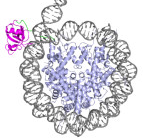Written by Professor James Davie, University of Manitoba, Canada
The nucleus produces an array of protein-coding and non-protein coding (nc)RNAs. There is growing appreciation and excitement in the role of the ncRNA in genome organization and function. ncRNA may have a role as genome organizing architectural factors of transcribed chromosomal domains (1, 2) and/or have a functional role such as ncRNA originating from enhancers (eRNAs) (3). Microinjection of RNase A into the nucleus of mammalian cells resulted in rearrangement of chromatin distribution with aggregation of chromatin at the nuclear periphery. This is a rather harsh treatment but it does make the case that nuclear RNA plays a role in the organization of the genome.
 A class of long ncRNA (lncRNAs), which do not overlap with protein-coding genes and activate transcription, is referred to as ncRNA-activating (4). Interestingly, knockdown of a ncRNA-activating specifically attenuated the expression of a “nearby” protein-coding gene; the median distance of a ncRNA-activating to the impacted protein-coding gene was over 100 kb in mammalian cells (4). A recent report shows that ncRNA-activating binds to mediator, a large multiprotein transcriptional coactivator (5).
A class of long ncRNA (lncRNAs), which do not overlap with protein-coding genes and activate transcription, is referred to as ncRNA-activating (4). Interestingly, knockdown of a ncRNA-activating specifically attenuated the expression of a “nearby” protein-coding gene; the median distance of a ncRNA-activating to the impacted protein-coding gene was over 100 kb in mammalian cells (4). A recent report shows that ncRNA-activating binds to mediator, a large multiprotein transcriptional coactivator (5).
Active enhancers produce eRNA which may play a role in the interaction between the enhancer and the promoter and the transcription of the nearby gene (3). These transcripts appear to be quite labile, and thus RNA sequencing may or may not detect these transcripts. One of the preferred methods to detect eRNA is a method described by Dr. John Lis and colleagues (6) called GRO-seq (global nuclear run-on coupled with massively parallel sequencing). It has been proposed that the eRNAs regulate transcription by promoting chromatin accessibility and RNAPII recruitment: processes that are required for the stabilization of enhancer-promoter interactions. Others argue that an interaction between the enhancer and promoter is required to produce eRNA. Regardless, it will be interesting to find out which epigenetic modifiers are associated with the eRNAs.
 There is mounting evidence that chromatin modifiers and remodelers bound to nuclear RNA play a key role in determining histone post-translational modification positions along chromatin (for recent reviews see (4, 7, 8)). Our interest in the RNA world peaked when we found that histone deacetylases (HDACs) and lysine acetyltransferases (KATs) were associated with the newly synthesized RNA (9). In our chromatin immunoprecipitation (ChIP) assays, we found that histone deacetylases appeared to be associated with the coding regions of genes. But if the cross-linked chromatin fragments were digested with RNase A before the immunoprecipitation with the HDAC antibodies, the interaction of the HDAC and coding region of the transcribed gene was lost. Similar observations have been made with splicing factors. This certainly raised a cautionary flag when interpreting results from ChIP assays.
There is mounting evidence that chromatin modifiers and remodelers bound to nuclear RNA play a key role in determining histone post-translational modification positions along chromatin (for recent reviews see (4, 7, 8)). Our interest in the RNA world peaked when we found that histone deacetylases (HDACs) and lysine acetyltransferases (KATs) were associated with the newly synthesized RNA (9). In our chromatin immunoprecipitation (ChIP) assays, we found that histone deacetylases appeared to be associated with the coding regions of genes. But if the cross-linked chromatin fragments were digested with RNase A before the immunoprecipitation with the HDAC antibodies, the interaction of the HDAC and coding region of the transcribed gene was lost. Similar observations have been made with splicing factors. This certainly raised a cautionary flag when interpreting results from ChIP assays.
The HDACs and KATs did not interact with RNA directly but bind to RNA-binding proteins involved in splicing of the pre-mRNA. It appears that these enzymes operate from the pre-mRNA to catalyze dynamic histone acetylation of the nearby chromatin coding region.
But not all nucleosomes are equal. In agreement with other reports (10, 11), we found that nucleosomes marked with H3K4 methylation (H3K4me3) were those that selectively participated in dynamic acetylation. During the course of these studies, it was also an eye opener that internal exons are about one nucleosome in length, that is 147 base pairs. In the case of the myeloid cell leukemia sequence 1 (MCL1) gene, a dynamically acetylated H3K4me3 nucleosome is planted on the alternative exon 2. Thus when the MCL1 RNA bound histone deacetylase activity is inhibited, the exon 2 nucleosome acetylation levels spike resulting in changes that play back to the MCL1 RNA by altering its splicing. I suppose it comes down to location, location, location.
References:
1. M. Caudron-Herger et al., Nucleus. 2, 410 (2011).
2. M. Caudron-Herger, K. Rippe, Curr. Opin. Genet. Dev. 22, 179 (2012).
3. F. Lai, R. Shiekhattar, Curr. Opin. Genet Dev. 25C, 38 (2014).
4. U. A. Orom, R. Shiekhattar, Trends Genet. 27, 433 (2011).
5. F. Lai et al., Nature 494, 497 (2013).
6. L. J. Core, J. J. Waterfall, J. T. Lis, Science 322, 1845 (2008).
7. S. Guil, M. Esteller, Nat. Struct. Mol. Biol. 19, 1068 (2012).
8. D. H. Khan, S. Jahan, J. R. Davie, Adv. Biol. Regul. 52, 377 (2012).
9. D. H. Khan et al., Nucleic Acids Res. 42, 1656 (2014).
10. Z. Wang et al., Cell 138, 1019 (2009).
11. C. A. Hazzalin, L. C. Mahadevan, PLoS. Biol. 3, e393 (2005).
Sam Rose
Latest posts by Sam Rose (see all)
- Raising funds for genetic diseases - 23rd September 2016
- The Epigenetics and Chromatin Clinic - 9th November 2015
- Resurrecting one of the oldest genetics journals - 23rd October 2015
Comments